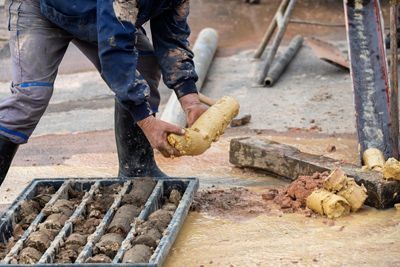Classification of Soils and Index Value Laboratory Tests - NYC, Manhattan, The Boroughs, Nassau County, Suffolk County, Long Island, and New Jersey - Kagaoan Engineering

Laboratory Tests for Soil Classification and Index Values Peer Reviews
The purpose of classification of soils and index value laboratory tests is to determine and categorize the physical and mechanical properties of soils. These tests are conducted to provide information about the soil's composition, behavior, and suitability for different engineering and construction purposes.
Contact us for free consultation.
Classification tests help in organizing soils into different groups based on their particle sizes, mineralogy, and plasticity characteristics. This classification allows engineers and geotechnical professionals to understand the soil's behavior and make informed decisions regarding its use in various applications such as road construction, foundation design, and slope stability analysis.
Index value laboratory tests, on the other hand, provide quantitative measurements of specific properties of the soil. These tests include the determination of moisture content, specific gravity, grain size distribution, Atterberg limits (liquid limit, plastic limit, and shrinkage limit), and compaction characteristics. The results of these tests help in assessing the engineering properties of the soil, such as its shear strength, compressibility, permeability, and ability to support loads.
Overall, the purpose of classification of soils and index value laboratory tests is to provide valuable information for engineers and geotechnical professionals to make informed decisions regarding the design, construction, and maintenance of structures and infrastructure on or in the soil.
The classification of soils is a fundamental aspect of geotechnical engineering. It provides valuable information about the engineering properties of soils, which is crucial for various construction projects. One important aspect of soil classification is the determination of its index value through laboratory tests. This article aims to provide an in-depth understanding of soil classification and the significance of index value laboratory tests.
I. Soil Classification
Soil classification is the process of categorizing soils based on their physical and engineering properties. It helps engineers and geotechnical professionals to assess the behavior and suitability of soils for different applications. Several classification systems are commonly used, including the Unified Soil Classification System (USCS) and the American Association of State Highway and Transportation Officials (AASHTO) classification system.
A. Unified Soil Classification System (USCS)
The USCS is extensively used in the United States and is based on the soil's particle size distribution and its plasticity characteristics. The classification divides soils into two main groups: coarse-grained soils and fine-grained soils. Coarse-grained soils are further classified based on their particle sizes, while fine-grained soils are classified based on their plasticity index and liquid limit.
B. AASHTO Classification System
The AASHTO classification system is primarily used for highway construction projects. It classifies soils based on their particle sizes and plasticity characteristics. The system categorizes soils into seven groups: A-1, A-2, A-3, A-4, A-5, A-6, and A-7. Each group represents different soil types with varying engineering properties.
II. Index Value Laboratory Tests
Index value laboratory tests are conducted to determine the physical and engineering properties of soils. These tests provide essential data required for soil classification and subsequent geotechnical analysis. The most common index value tests include the Atterberg limits test, grain size analysis, and compaction test.
A. Atterberg Limits Test
The Atterberg limits test consists of three components: liquid limit (LL), plastic limit (PL), and shrinkage limit (SL). The liquid limit represents the moisture content at which a soil transitions from a liquid to a plastic state. The plastic limit indicates the moisture content where the soil changes from a plastic to a semi-solid state. The shrinkage limit determines the moisture content at which the soil no longer undergoes any volume change.
B. Grain Size Analysis
Grain size analysis, also known as sieve analysis, determines the distribution of particle sizes in a soil sample. This test involves passing a soil sample through a series of sieves with progressively smaller openings. The retained soil on each sieve is weighed, and the cumulative percentage of soil retained is plotted on a grain size distribution curve. This information is essential for soil classification and determining the soil's engineering properties.
C. Compaction Test
The compaction test determines the maximum dry unit weight and optimum moisture content of a soil. It is typically performed on cohesive soils, such as clay and silt. The test involves compacting soil samples at different moisture content levels and measuring their dry unit weight. The results help in determining the soil's compaction characteristics and its suitability for construction purposes.
Who Would Need Classification of Soils and Index Value Laboratory Tests?
1. Geotechnical Engineers: Geotechnical engineers are primarily responsible for assessing the properties of soils and their suitability for construction projects. They require a thorough understanding of soil classification and index value laboratory tests to make informed decisions about soil selection, foundation design, and slope stability analysis.
2. Civil Engineers: Civil engineers involved in infrastructure projects, such as roads, bridges, and buildings, need to understand soil classification and index value laboratory tests to ensure the stability and safety of their structures. They rely on this information to determine the appropriate soil types for different components of their projects.
3. Construction Contractors: Construction contractors need to be aware of soil classification and index value laboratory tests to effectively manage construction activities. They rely on this information to plan excavation, earthwork, and soil compaction processes, ensuring that the soil meets the necessary engineering requirements.
4. Environmental Consultants: Environmental consultants dealing with contaminated soil remediation or land reclamation projects need to understand soil classification and index value tests. They use this knowledge to assess the suitability of soils for remediation, determine the extent of contamination, and monitor the effectiveness of soil treatment processes.
5. Researchers and Academics: Researchers and academics in the field of geotechnical engineering and soil science require a comprehensive understanding of soil classification and index value laboratory tests for their studies and publications. Their research contributes to the development of new techniques and methods in soil classification, improving the overall understanding of soil behavior.
6. Regulatory Bodies and Government Agencies: Regulatory bodies and government agencies responsible for developing and enforcing construction regulations rely on soil classification and index value laboratory tests to ensure compliance with safety standards. They use this information to establish guidelines for soil use and provide recommendations to engineers and contractors.
7. Land Developers: Land developers need to assess the soil conditions of a site before planning and designing any construction projects. Understanding soil classification and index value laboratory tests helps them make informed decisions about land use, site preparation, and infrastructure development.
8. Architects: Architects rely on soil classification and index value laboratory tests to understand the properties of the soil on which their structures will be built. This knowledge helps them design foundations, basements, and other structural elements that are compatible with the specific soil conditions.
Soil classification and index value laboratory tests play a vital role in geotechnical engineering. They provide valuable information about the physical and engineering properties of soils, which is essential for designing and constructing various infrastructure projects. Understanding the soil classification systems, such as the USCS and AASHTO, along with conducting index value laboratory tests, allows engineers to make informed decisions regarding the selection and usage of soils in construction projects.
Overall, anyone involved in construction, geotechnical engineering, or soil-related projects can benefit from understanding soil classification and index value laboratory tests. It provides valuable insights into the properties and behavior of soils, allowing for informed decision-making and ensuring the success and safety of construction projects.
Please contact us for a free consultation.

